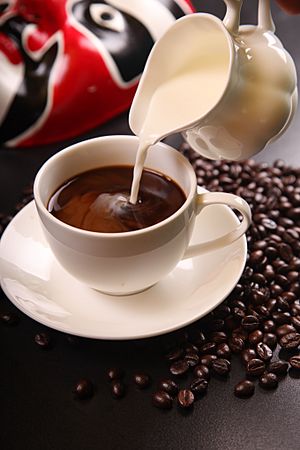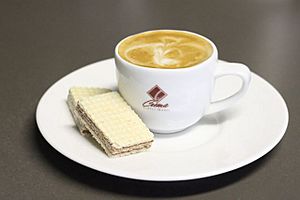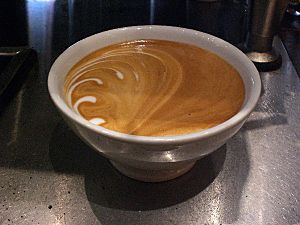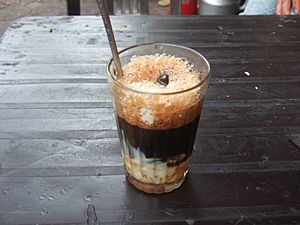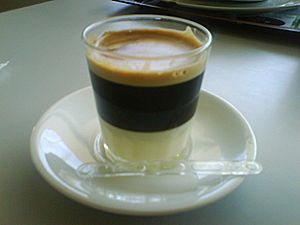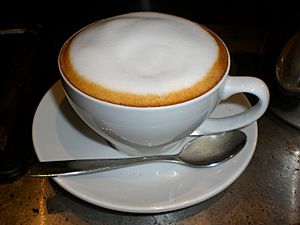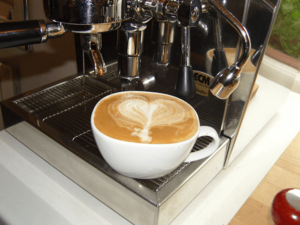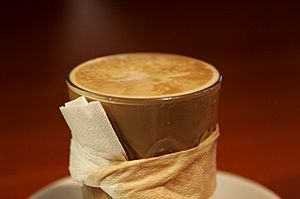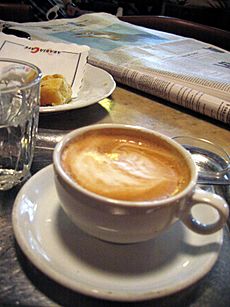Milk coffee facts for kids
Milk coffee is a type of coffee drink that has milk added to it. It's a popular choice for many people around the world!
Did you know that the first person to drink coffee with milk might have been Johan Nieuhof? He was a Dutch ambassador who tried it way back in the 1660s.
Contents
- Milk Coffee: A World of Flavors
- Different Kinds of Milk Coffee
- Antoccino
- Breve
- Café au lait
- Ca phe sua
- Café bombón
- Cafe Hafuch
- Cappuccino
- Cortado
- Café con leche
- Egg coffee
- Eggnog latte
- Eiskaffee
- Espressino
- Espresso con panna
- Flat white
- Galão
- Caffè gommosa
- Indian Filter Coffee
- Kopi susu
- Latte
- Latte macchiato
- Macchiato
- Wiener or Viennese melange
- White coffee
- White coffee (UK)
- Vienna coffee
- Coffee Regular
- Different Kinds of Milk Coffee
- See also
Milk Coffee: A World of Flavors
Different Kinds of Milk Coffee
There are many exciting ways to mix coffee and milk. Each kind has its own special taste and way of being made. Let's explore some of them!
Antoccino
An antoccino is a small coffee drink. It has one shot of espresso mixed with the same amount of steamed milk. It's served in a tiny espresso cup. Even though it sounds Italian, this drink doesn't actually come from Italy.
Breve
A breve is an espresso made with a special mix of half milk and half cream. This makes it extra rich and creamy! The name "breve" comes from using both cream and milk.
Café au lait
"Café au lait" means "coffee with milk" in French. It's a very common way to enjoy coffee in Europe. Many countries have their own names for it, like "caffè latte" in Italy or "Milchkaffee" in Germany. In the United States, a café au lait is usually strong coffee mixed with warm milk in equal parts.
Ca phe sua
Vietnamese "cà phê sữa đá" is an "iced milk coffee." It's made with strong, dark coffee, often mixed with chicory. The coffee is brewed using a special Vietnamese filter. It drips into a cup that already has sweetened condensed milk at the bottom. You stir the milk and coffee, then pour it over ice. If you want it hot, it's called "cà phê sữa nóng."
Café bombón
Café bombón became popular in Valencia, Spain. It's an espresso served with sweetened condensed milk, usually in equal amounts. This drink is similar to "Kopi Susu Panas" found in Malaysia and Thailand. For a cool look, it's often served in a glass. The heavy condensed milk sinks below the coffee, making two colorful layers. Most people stir it before drinking!
Cafe Hafuch
"Cafe Hafuch" means "upside down coffee" and is popular in Israel. For this drink, the steamed milk goes into the cup first. Then, the espresso is carefully added on top. This creates a layered look, which is why it's called "upside down." Usually, coffee goes in first, then milk.
Cappuccino
A Cappuccino is a classic coffee drink. It's made with espresso, hot milk, and a thick layer of steamed milk foam. Cappuccinos have less milk than a latte. The foam on top often rises above the cup. It's usually served in a porcelain cup, which keeps the drink warm longer. The foam also helps to trap the heat!
Cortado
A cortado is an espresso "cut" with warm milk. "Cortado" comes from the Spanish word for "cut." The milk helps to make the coffee less strong. It has very little foam, but some baristas make a small amount to create latte art. This drink is popular in Spain, Portugal, and Latin America.
Café con leche
Café con leche is a very common Spanish drink. It simply means "coffee with milk." It's usually served in a large cup, often used for breakfast. The amount of coffee and milk is usually about half and half.
Egg coffee
Egg coffee is a special Vietnamese drink. It's made with egg yolks, sugar, condensed milk, and strong Robusta coffee. It's a unique and creamy coffee experience!
Eggnog latte
This is a popular drink during autumn and winter. It mixes steamed milk and eggnog with espresso. Sometimes, a sprinkle of nutmeg is added on top.
Eiskaffee
Eiskaffee means "ice cream coffee" in German. It's a cool and tasty drink. It has chilled coffee, vanilla ice cream, and sometimes sugar or whipped cream.
Espressino
An espressino is made with espresso, steamed milk, and cocoa powder. It's similar to another drink called a Marocchino.
Espresso con panna
Espresso con panna is a simple but delicious coffee. It's just coffee topped with whipped cream.
Flat white
A flat white is an espresso drink with milk. It's similar to a latte or cappuccino, but the milk has a different, smoother texture. It started in Australia in the 1980s as a less frothy option than a cappuccino. It then became popular in New Zealand and the UK. To make it "flat," the milk is steamed to have very small bubbles. This makes the drink smooth and velvety.
Galão
Galão is a hot drink from Portugal. It's made with espresso and foamed milk. It's like a caffè latte but served in a tall glass with lots of milk. If it has only half milk, it's called "meia de leite."
Caffè gommosa
A caffè gommosa is a shot of espresso poured over a single marshmallow. It started in coffee shops in America's Pacific Northwest. The drink becomes sweet and thick, which is why it's called "caffè gommosa," meaning "rubbery coffee."
Indian Filter Coffee
South Indian filter coffee is made by mixing frothed, boiled milk with strong coffee. The coffee is brewed using a special Indian filter. This drink is also known as Kaapi.
Kopi susu
Kopi susu is found in Malaysia, Borneo, and Indonesia. "Kopi susu" simply means "milk coffee." It's made by mixing black coffee with sweetened condensed milk in a glass. You let it cool and the coffee grounds sink to the bottom.
Latte
A latte is a very popular coffee drink. It has espresso and a lot of steamed milk, usually with a little foam on top. In Italy, it's called "caffè latte," which means "coffee and milk." You can also find variations like the chocolate-flavored mocha. Other types of milk, like soy milk or almond milk, can also be used.
Latte macchiato
Latte macchiato means stained milk. This name comes from how it's made: the milk gets "stained" when espresso is added to it. It's different from a regular latte because the espresso is added to the milk (not the other way around). It also has more foam and is often served in layers. In a latte macchiato, the milk is the main star!
Macchiato
Macchiato means "stained." It's an espresso with a small amount of foamed milk. It looks like a tiny cappuccino, but it tastes much stronger. The milk is foamed right into the espresso cup. Sometimes, cocoa powder is sprinkled on top.
Wiener or Viennese melange
Melange is popular in Austria, Switzerland, and the Netherlands. It's similar to a latte or cappuccino. It has espresso, steamed milk, and milk foam, served in a large cup. Sometimes, it's even topped with whipped cream! Outside of Vienna, it's often called a Wiener Melange.
White coffee
Ipoh white coffee is a popular drink from Malaysia. The coffee beans are roasted with palm-oil margarine. The coffee is then served with condensed milk. It tastes smooth and sweet, and is often served cold.
White coffee (UK)
In the UK, "white coffee" simply means black coffee with fresh cold milk added. Sometimes, hot milk is used instead.
Vienna coffee
A Vienna coffee is coffee or espresso topped with whipped cream. Sometimes, milk is added before the whipped cream. You might also find vanilla, chocolate, or cinnamon sprinkled on top.
Coffee Regular
In New England (a region in the United States), a "regular coffee" means coffee with cream and sugar. Usually, it's made with three creams and three sugars. You can have it hot or as iced coffee.
See also
 In Spanish: Café con leche para niños
In Spanish: Café con leche para niños


